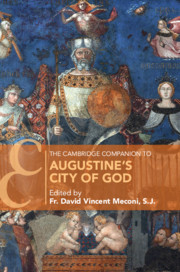Book contents
- The Cambridge Companion to Augustine’s City of God
- Cambridge Companions to Religion
- The Cambridge Companion to Augustine’s City of God
- Copyright page
- Dedication
- Contents
- Notes on Contributors
- Preface
- Abbreviations: Works by Augustine
- 1 Introduction
- 2 Book 1
- 3 Book 2
- 4 Book 3
- 5 Books 4 & 5
- 6 Books 6 & 7
- 7 Books 8–10
- 8 Books 11 & 12
- 9 Books 13 & 14
- 10 Books 15 & 16
- 11 Books 17 & 18
- 12 Book 19
- 13 Book 20
- 14 Books 21 & 22
- 15 Epilogue
- References
- Index
- References
15 - Epilogue
The Architectonic Plan of The City of God
Published online by Cambridge University Press: 21 August 2021
- The Cambridge Companion to Augustine’s City of God
- Cambridge Companions to Religion
- The Cambridge Companion to Augustine’s City of God
- Copyright page
- Dedication
- Contents
- Notes on Contributors
- Preface
- Abbreviations: Works by Augustine
- 1 Introduction
- 2 Book 1
- 3 Book 2
- 4 Book 3
- 5 Books 4 & 5
- 6 Books 6 & 7
- 7 Books 8–10
- 8 Books 11 & 12
- 9 Books 13 & 14
- 10 Books 15 & 16
- 11 Books 17 & 18
- 12 Book 19
- 13 Book 20
- 14 Books 21 & 22
- 15 Epilogue
- References
- Index
- References
Summary
Nothing is more evident, seemingly, about Augustine’s ciu. Dei than its structure. Any reasonably serious relevant website reveals that it is divided into two “halves,” comprising Books 1–10 and 11–22, each further subdivided into halves and thirds, respectively. Augustine himself accounts for the structure in just this way. In retr. he distinguishes the first ten books and the last twelve as the main textual units. The first ten respond to “two groundless opinions that are opposed to the Christian religion.” The first five reply to “those who would have it that human success depends on what they regard as the essential observance of the many gods whom they customarily worship”; the next five books rebut those who argue that the observance they make to the multitude of gods by sacrificing brings profit to life after death.” Augustine adds, lest it be objected that he would then have done nothing but refute the opinions of others without asserting any of his own, the last twelve books accomplish this goal: “in the twelve books that come later, the first four contain an account of the rise of the two cities, the City of God and the city of this world, the second four expound their growth or progress, and the third and final four their appointed ends.” Thus the first “half” leads with response and refutation, and the second half with constructive theology. As Augustine also observes, however, this distinction is not absolute: “Nonetheless, where necessary I both maintain our own standpoint in the first ten books, and reject the opposing views in the later twelve” (retr. 2.69; see also, ep. 1A*.1).
- Type
- Chapter
- Information
- The Cambridge Companion to Augustine's City of God , pp. 297 - 320Publisher: Cambridge University PressPrint publication year: 2021
References
Further Reading
- 1
- Cited by



